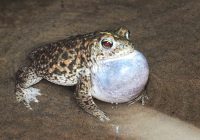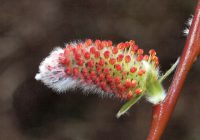Dr Phil Smith’s Wildlife Notes
April 2016
We actually had April showers in the first week, something rarely experienced since 2008. There followed the inevitable fourteen-day April drought, with temperatures well below average. Unsettled conditions then returned for the last few days; some places even had snow. Although the dune water-table slowly fell, adequate rain during winter ensured that dune wetlands had enough water for our hard-pressed Natterjack Toads. Males started to return to the breeding pools early in the month, their insistent vibrant calls soon attracting females from hundreds of metres away. With other volunteers, I counted spawn strings at several different sites, my total for the southern Green Beach reaching 53 by 16th. A night-time safari to Ainsdale Sandhills with Patricia Lockwood on 13th targeted Natterjack scrapes dug by the Sefton Landscape Partnership Scheme. Although conditions were not ideal, our luck was in and we encountered several males calling, together with three pairs. I even managed to photograph one male with his balloon-like vocal sac fully inflated. A recent national report confirms we have the largest Natterjack population in the country. Fingers crossed for successful breeding this year after a sequence of poor seasons due to drought.
April is the month for blossoming trees and shrubs, including the willows with their well known catkins. Readers of these notes will be aware of my interest in this group, especially the rare hybrids, with which the Sefton Coast is uniquely endowed. This interest seems to be spreading, as I was asked to guide a group of four naturalists who wanted to see a selection of willows. Accordingly, I took them to Queen’s Jubilee Nature Trail, the nearby Oxford Road dunes and Hightown, where we were able to catch up with our four rarest hybrids. My favourite is Don’s Willow, a cross between Purple and Creeping Willow with superb red-tinged male catkins. Currently, only about 37 bushes of this hybrid are known in Britain and 34 of them are on the Sefton dunes.
Other April flowers include the tiny dune annuals that appear in abundance at this time of year. The Rue-leaved Saxifrage did especially well, while the rare coastal form of Groundsel was again a feature of the southern end of Birkdale Green Beach. I also called at Ashdale Close, Formby, where a relict patch of woodland supports a dense colony of Moschatel, sometimes known as Townhall Clock because of the strange arrangement of the flowers. This seems to be its only locality for miles around.
Our duneland is renowned for its diversity of bees and wasps, the excellent new field guide to the bees of Great Britain and Ireland giving an incentive to study these fascinating and useful pollinators. Our most familiar solitary bee is the Vernal Mining Bee (or Early Colletes), which looks like a dark furry honey bee tunnelling into south-facing dune slopes. Its numbers this year have been greater than I ever remember. For example, I estimated about 1000 burrows on the sand-ridges near Hightown Sailing Club that were created for conservation purposes during the 2011 coast protection scheme. With the help of Lancashire Wildlife Trust specialist, Ben Hargreaves, I identified three more solitary bees in the dunes – the Sandpit Mining Bee, Chocolate Mining Bee and Tawny Mining Bee.
Birds often make the headlines in April as returning migrants sometimes include rarities. This year there were several Ring Ouzels in the dunes, Ospreys seen flying north and a Great Grey Shrike at Marshside, while Smew and Black-necked Grebe graced Lunt Meadows. Needless to say, I managed to miss them all. Nevertheless, visits to Marshside on 10th and 11th were rewarded with Water Pipit, a Raven, a pair of Scaup, one Little Gull, four Mediterranean Gulls, five Eiders, two Greenland Whitefronts, 17 White Wagtails and two enormous flocks of Pink-footed Geese, totalling about 7500 birds. Presumably, these were waiting for favourable winds before heading back to Iceland to breed. Often, the more mundane is just as enjoyable as the unusual. Listening to the glorious descending trill of the Willow Warbler or watching a continuous stream of Swallows heading north in the April sunshine takes some beating. I was also pleased to find about 50 Black-headed Gulls nesting on one of the big slacks in Ainsdale National Nature Reserve. This colony was reported for the first time in 2014.
Following a national decline of around 90% since 1970, the Redpoll has become really scarce in our area. However, the good news from the British Trust for Ornithology is that numbers are picking up again. I saw or heard several during April and Patricia Lockwood’s garden feeders attracted a superbly colourful breeding-plumage male which I managed to photograph through her kitchen window.




